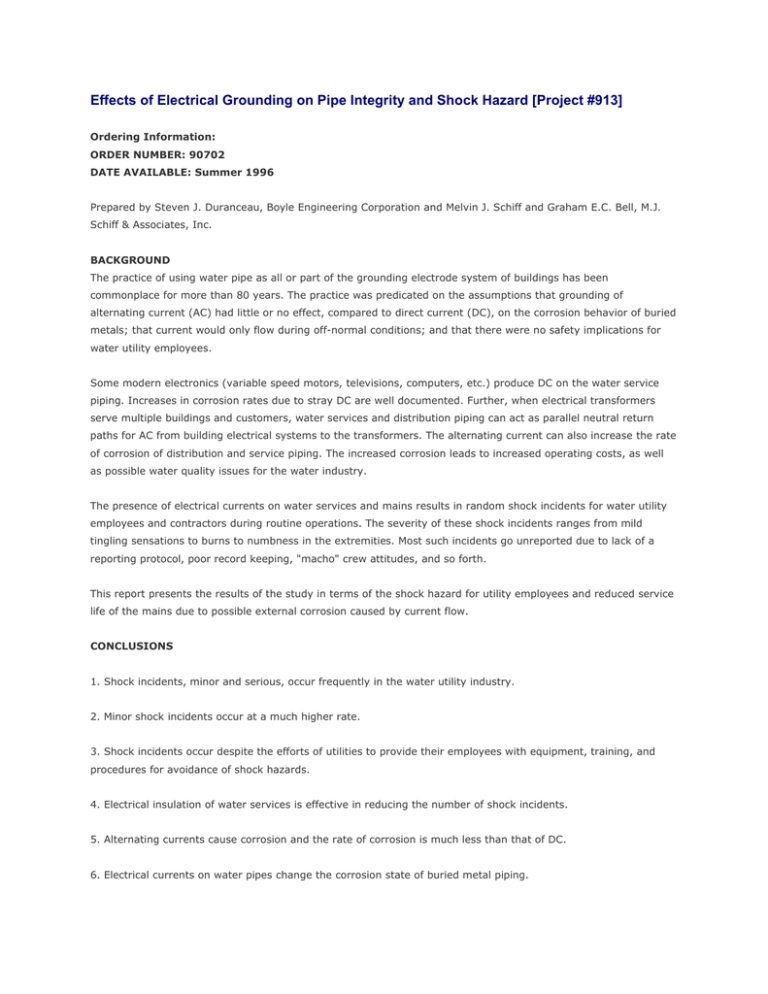Effects of Electrical Grounding on Pipe Integrity and Shock Hazard
advertisement

Effects of Electrical Grounding on Pipe Integrity and Shock Hazard [Project #913] Ordering Information: ORDER NUMBER: 90702 DATE AVAILABLE: Summer 1996 Prepared by Steven J. Duranceau, Boyle Engineering Corporation and Melvin J. Schiff and Graham E.C. Bell, M.J. Schiff & Associates, Inc. BACKGROUND The practice of using water pipe as all or part of the grounding electrode system of buildings has been commonplace for more than 80 years. The practice was predicated on the assumptions that grounding of alternating current (AC) had little or no effect, compared to direct current (DC), on the corrosion behavior of buried metals; that current would only flow during off-normal conditions; and that there were no safety implications for water utility employees. Some modern electronics (variable speed motors, televisions, computers, etc.) produce DC on the water service piping. Increases in corrosion rates due to stray DC are well documented. Further, when electrical transformers serve multiple buildings and customers, water services and distribution piping can act as parallel neutral return paths for AC from building electrical systems to the transformers. The alternating current can also increase the rate of corrosion of distribution and service piping. The increased corrosion leads to increased operating costs, as well as possible water quality issues for the water industry. The presence of electrical currents on water services and mains results in random shock incidents for water utility employees and contractors during routine operations. The severity of these shock incidents ranges from mild tingling sensations to burns to numbness in the extremities. Most such incidents go unreported due to lack of a reporting protocol, poor record keeping, "macho" crew attitudes, and so forth. This report presents the results of the study in terms of the shock hazard for utility employees and reduced service life of the mains due to possible external corrosion caused by current flow. CONCLUSIONS 1. Shock incidents, minor and serious, occur frequently in the water utility industry. 2. Minor shock incidents occur at a much higher rate. 3. Shock incidents occur despite the efforts of utilities to provide their employees with equipment, training, and procedures for avoidance of shock hazards. 4. Electrical insulation of water services is effective in reducing the number of shock incidents. 5. Alternating currents cause corrosion and the rate of corrosion is much less than that of DC. 6. Electrical currents on water pipes change the corrosion state of buried metal piping. 7. Relatively high amounts (greater than 1 amp-AC) of alternating current were found on more than fifty percent of the water services tested during this investigation. 8. Electrically resistive, but not insulating, connections in metal piping systems are common and have an effect on grounding currents, which in turn affect pipe integrity. 9. Electrical insulators can affect water quality in terms of metal release. RECOMMENDATIONS 1. The water utility industry should formally and directly approach the electric power distribution utility industry and the National Electric Code (NEC) committee of the National Fire Protection Association and declare their intent to electrically insulate exterior water services. 2. If a utility decides to install electrical insulation in an existing water service, the utility should coordinate with the power company and inform the building owner of the impending changes. 3. Water utilities should implement safety procedures consistent with state, local and federal requirements for protecting their employees from shock hazards inherent with water service piping which is bonded to the electric power system. 4. The NEC should be changed to require adequate grounding of a structure without considering the presence of underground water pipe. 5. Elevated lead and copper concentrations may be related to high levels of AC/DC current. FUTURE RESEARCH The decision to insulate water services is not simply a technical decision based on this or other reports. The question involves local, state, and federal agencies, including the U.S. Environmental Protection Agency and Occupational Safety and Health Administration, as well as consideration of indemnification and litigation risk. The legal and political implications are beyond the scope of this work and have not been addressed in depth by any previous study. The water utility industry should conduct a study to determine the specific legal liability of electrical insulation of water services. The study should include potential litigation exposure from employees and customers, as well as from contractors and subcontractors who perform work for utilities and customers. The brief tests of the effects of insulators on water quality which were found in this study for copper release should be extended to other pipe materials, lead in particular, and profiled for other water sources and treatment. Field verification and laboratory investigation of the effects should be pursued. Touch read, radio, and remote meter reading systems rely on the measurement of a voltage signal to register water consumption and calculate the customer's bill. As far as can be determined, the possible effect of grounding currents and voltages on meter system accuracy has not been investigated.


